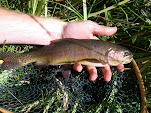One of my goals this past winter was to start to dial in the fishing at my local beach a bit more. However, after a half dozen fruitless trips I was starting to give up on this particular spot for this time of the year. My main draw with this beach has just been its proximity to home, but so far I have found the fishing to be spotty at best. Part of the challenge has just been learning the beach, as different beaches fish better or worse on different tides and particular times of the year. While I had over a dozen beaches close to home and dialed in when I lived in the Tacoma area, Olympia has been like starting over again much more challenging to just find access to beaches.
Part of the challenge is that some beaches are traveling beaches, where Cutthroat cruise the shoreline looking for food and others are holding spots that consistently produce. This particular beach seems to fit into the first category and as such I have been be hitting it for short 30 minute intervals throughout the winter to try to pin down when and where the fish are most likely to stop and hold as they cruise along the shore.
 |
| Beautiful weather on the beach |
This particular outing I was treated by a rare western Washington bluebird late-winter day, with no wind and a strong outgoing tide, as good of conditions as I could ask for. To make sure I was prepared for any situation I brought two rods, one with a floating crippled baitfish and the other with a sinking shrimp pattern. With the dead calm conditions, I started working the beach with a surface fly at small point, but and kept the second rod in reserve just in case. For the next 30 minutes I covered a good piece of water around a point and into a slight cove where I have caught fish during the summer months, but didn't have any initial luck. However, as the tide dropped I moved back to the point, where a good current had picked up and the tide was a perfect level for fish to cruise over a patch of broken shells and barnacle covered rocks, which is a substrate that often produces sea-runs.
Sure enough a few minutes later I had a fish roll on my surface fly about 30 feet in front of me but it didn't take. Another cast with the surface fly failed to get any attention, so I quickly switched over to my other rod, made a cast and sure enough after a few quick strips I got a solid take and hooked into a decent fish. One thing I love about sea-run Cutthroat is how hard they fight for their size, and this fish was no exception, even giving my 6WT a run for its money. Luckily I got a good hookset and within a couple minutes was able to slide my net under the chrome bright native Cutthroat.
 |
| A flawless sea-run Coastal Cutthroat |














